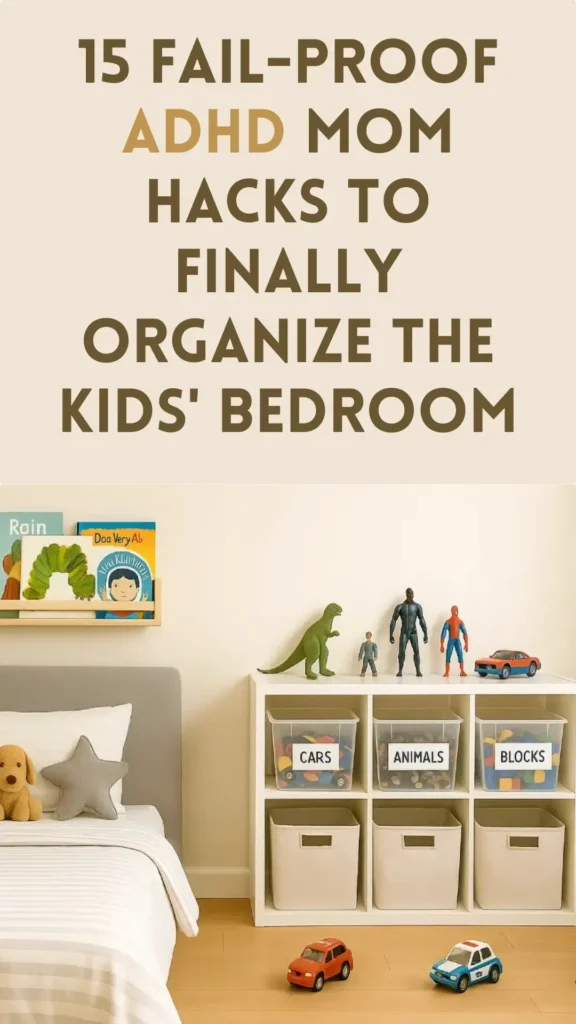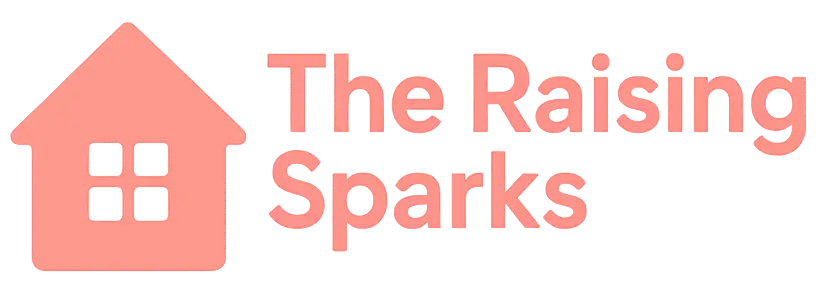Does your kid’s room feel like a never-ending tornado of toys, clothes, and mystery items? I get it completely.
As a mom with ADHD, trying to organize your child’s bedroom can feel like attempting to capture smoke with your bare hands. It’s overwhelming before you even start, and somehow gets messier the harder you try.
Here’s the part that used to drive me crazy: I’d spend hours cleaning and organizing, only to find the room looking exactly the same (or worse) just two days later.
But here’s what I’ve learned: it’s not about working harder. It’s about working with your ADHD brain instead of fighting against it.
These 15 strategies aren’t Pinterest-perfect solutions. They’re real, tested methods that work for moms like us who need systems that actually stick.
📌 Don’t forget to save this pin for later so you can come back to these tips whenever you need them!

Let’s dive in.
1. Start Small With a “Micro-Zone Reset”
Forget about tackling the entire room. That’s a recipe for overwhelm and abandonment.
Instead, choose one tiny area. A single drawer, one shelf, or just the corner by the door.
Focus all your energy on making that one small space completely organized. ADHD brains feed on visible progress, and these mini-victories create momentum that carries you forward.
I remember spending an entire hour just organizing the top of my daughter’s dresser. The rest of the room was still a disaster, but every time I walked past that perfectly arranged surface, I felt a surge of accomplishment.
That feeling? It gradually spread to other areas.
2. Take a Quick “Before” Photo
This simple step forces you to actually see the mess instead of just feeling overwhelmed by it. When we’re in the middle of chaos, our brains can’t process what needs to happen next.
After you snap the photo, take a moment to visualize what that space could look like when it’s organized. This mental shift from “this is impossible” to “this is the goal” can be the spark your brain needs to get moving.
It’s not about judging yourself. It’s about creating clarity and direction.
3. Use Picture Labels, Not Just Words
If you’re like me, you’ve probably walked into a room with a specific purpose, only to completely forget what you came for. Visual labels eliminate this frustration entirely.
Photos make it crystal clear where everything belongs. No reading required, no mental processing needed. Just match the item to the picture.
This works beautifully for kids too, and it’s a lifesaver when other family members are helping with cleanup.
4. Set a 10-Minute Reset Rule
Choose a consistent time each day. Maybe right after school or before bedtime. Set a timer for 10 minutes and tackle just one small task.
This short timeframe prevents the overwhelm that makes us want to avoid the task altogether. It’s long enough to make real progress but short enough that it doesn’t feel impossible on tough days.
5. Create a “Rescue Basket” for Clutter You Can’t Handle Right Now
We’ve all been there: standing in the middle of a messy room, holding random items, and thinking “I have no idea what to do with any of this.” Instead of shutting down completely, give yourself an out.
Keep a designated basket or bin for items you can’t categorize in the moment. Label it “Sort Later” and resist the urge to judge yourself for using it.
You’re not procrastinating. You’re preventing decision fatigue and keeping the organizing process moving forward.
6. Don’t Buy Containers Yet (Sort First)
I learned this lesson the hard way after multiple trips to Target that resulted in bins full of junk I didn’t actually need. Before you invest in any storage solutions, go through everything first.
Create three piles: keep, trash, and donate. Be ruthless here.
Only after you know exactly what you’re keeping should you buy containers that fit those specific items. This approach will save you money, space, and the frustration of storage that doesn’t actually solve the problem.
7. Use Small, Open Bins (One Category Each)
Large toy boxes are organizing disasters waiting to happen. When everything gets dumped together, finding anything becomes impossible, and putting things away feels overwhelming.
Instead, use smaller containers for specific categories: one for LEGOs, one for dolls, one for art supplies. Keep them open-top whenever possible.
The less friction between “I need to put this away” and “it’s put away,” the more likely everyone is to follow through.
8. Use Under-Bed Storage Like a Secret Weapon
Flat storage bins that slide under the bed are perfect for items that need to be kept but don’t need daily access. Think keepsakes, seasonal clothes, or those sentimental items you’re not ready to donate but don’t want cluttering up the room.
Clear surfaces lead to clearer thinking, and this hidden storage keeps your visual space calm while maintaining easy access when needed.
9. Build a “Weekend Reset” Ritual That You Actually Enjoy
The key to making any routine stick is pairing it with something you already look forward to. Maybe it’s Saturday morning with your favorite coffee and a podcast, or Sunday evening with an upbeat playlist.
Find what makes you feel good and attach your organizing time to it. This transforms the task from a chore into something that feels more like self-care.
10. Adopt the “One In, One Out” Rule (Quietly)
Every time something new enters the room (a toy, book, piece of clothing), quietly let one thing go. You don’t need to make announcements or turn it into a big production. Just do it behind the scenes.
Over time, you’ll notice the overall clutter naturally decreasing without the stress of a major purge. This gentle approach prevents accumulation without creating battles.
11. Create a “Donate Later” Box in the Closet
For items you’re unsure about, create a holding space. No pressure to decide immediately, no guilt about being indecisive. Just get questionable items out of the daily visual mix.
You can revisit the box when your brain has more bandwidth for decision-making. Often, items that sit in this box for a few months naturally feel easier to let go of.
12. Skip Dressers (Go for Cubbies or Open Shelves)
Drawers are where clothes go to die. They become layers of forgotten items that are impossible to navigate. Open cubbies or shelves make everything visible and accessible.
When you can see what’s available, getting dressed becomes easier, and putting clean clothes away stops feeling like a puzzle. Your future self will thank you when you’re not digging through mystery layers at 7 AM.
13. Protect a “Visual Calm Zone”
Designate one surface that stays completely clear. Maybe the top of a dresser, a corner of the room, or one shelf. No exceptions.
ADHD brains are easily overwhelmed by visual chaos. Having one peaceful spot for your eyes to rest can anchor your entire day and provide a sense of control when everything else feels hectic.
14. Designate a “Daily Stuff Station”
Create one central spot for today’s essentials: tomorrow’s outfit, school backpack, current favorite toy, or whatever items are in heavy rotation. This prevents high-traffic items from becoming high-clutter stress throughout the room.
Having a designated landing spot for daily necessities means less searching and less scattering.
15. Make “Lazy” Choices on Purpose
If tossing toys into a labeled bin works better than carefully arranging them on a shelf, choose the bin every time. Efficiency beats effort when it comes to sustainable systems.
The goal isn’t to impress anyone or achieve Pinterest perfection. It’s to create a system that actually functions on the days when your brain doesn’t want to cooperate.
Final Thoughts: You’re Not Broken, the System Is
If you’ve felt like no matter how hard you try, the clutter keeps winning, please know that you’re not failing. You just haven’t had strategies designed for how your brain actually works.
These approaches aren’t about achieving perfection. They’re about making daily life easier, lighter, and more manageable. They’re about creating a home that supports you instead of constantly draining your energy.
You deserve a home that works for you, not against you. And it absolutely is possible to get there, one small win at a time.
